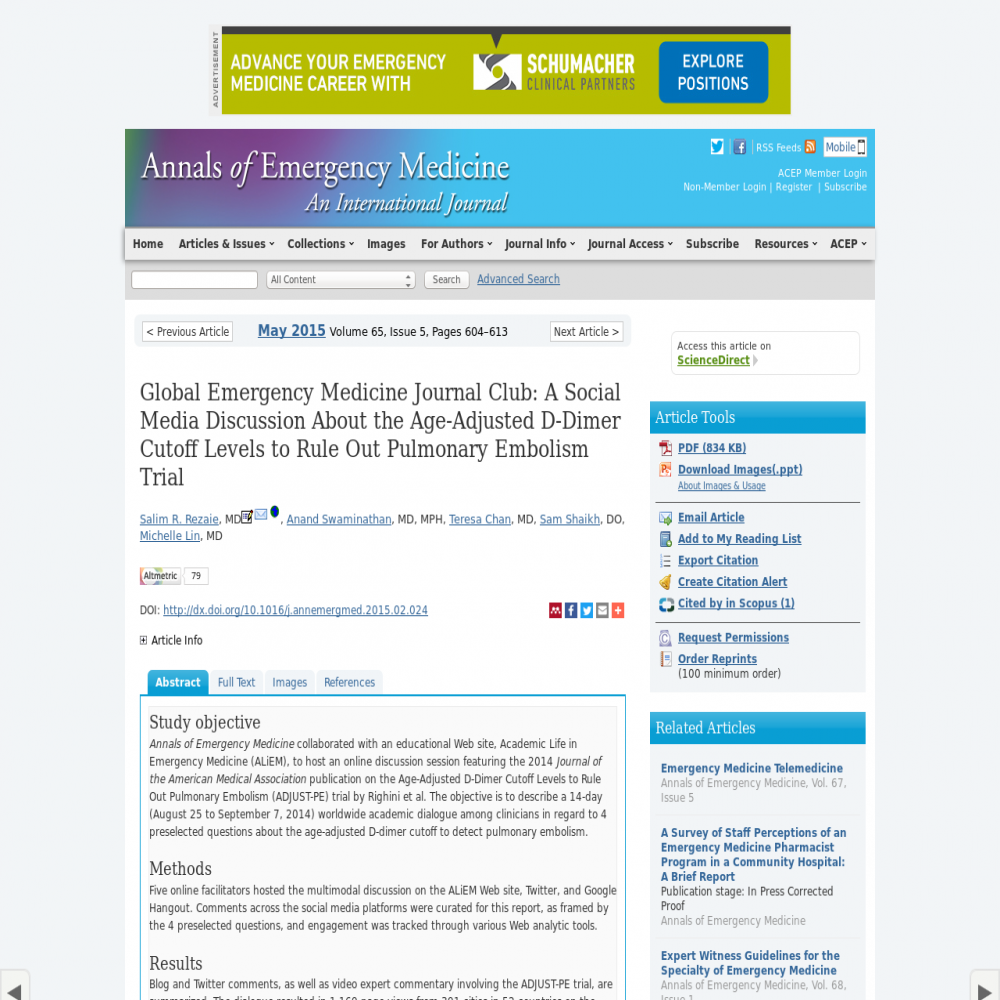Global Emergency Medicine Journal Club: A Social Media Discussion About the Age-Adjusted D-Dimer Cutoff Levels to Rule Out Pulmonary Embolism Trial
A healthcare social media research article published in Annals of Emergency Medicine, May 1, 2015
- Title
- Global Emergency Medicine Journal Club: A Social Media Discussion About the Age-Adjusted D-Dimer Cutoff Levels to Rule Out Pulmonary Embolism Trial
- Authors (alpha)
- Anand Swaminathan, Michelle Lin, Salim R. Rezaie, Sam Shaikh, Teresa Chan
- Published
- May 1, 2015
- Journal
- Annals of Emergency Medicine
- Impact Factor
- 4.676
- DOI
- 10.1016/j.annemergmed.2015.02.024
- Pubmed
- 25840845
- Altmetric
Abstract
Annals of Emergency Medicine collaborated with an educational Web site, Academic Life in Emergency Medicine (ALiEM), to host an online discussion session featuring the 2014 Journal of the American Medical Association publication on the Age-Adjusted D-Dimer Cutoff Levels to Rule Out Pulmonary Embolism (ADJUST-PE) trial by Righini et al. The objective is to describe a 14-day (August 25 to September 7, 2014) worldwide academic dialogue among clinicians in regard to 4 preselected questions about the age-adjusted D-dimer cutoff to detect pulmonary embolism. Five online facilitators hosted the multimodal discussion on the ALiEM Web site, Twitter, and Google Hangout. Comments across the social media platforms were curated for this report, as framed by the 4 preselected questions, and engagement was tracked through various Web analytic tools. Blog and Twitter comments, as well as video expert commentary involving the ADJUST-PE trial, are summarized. The dialogue resulted in 1,169 page views from 391 cities in 52 countries on the ALiEM Web site, 502,485 Twitter impressions, and 159 views of the video interview with experts. A postdiscussion summary on the Journal Jam podcast resulted in 3,962 downloads in its first week of publication during September 16 to 23, 2014. Common themes that arose in the multimodal discussions included the heterogeneity of practices, D-dimer assays, provider knowledge about these assays, and prevalence rates in different areas of the world. This educational approach using social media technologies demonstrates a free, asynchronous means to engage a worldwide audience in scholarly discourse.
Altmetric
The Altmetric Attention Score is based on the attention a research article gets on the internet. Each coloured thread in the circle represents a different type of online attention and the number in the centre is the Altmetric Attention Score. The score is calculated based on two main sources of online attention: social media and mainstream news media.
Healthcare Social Media Research
See the full list of healthcare social media research articles with data from or reference to Symplur.
#hcsmR is a collaboration between Stanford Medicine X and Symplur.


